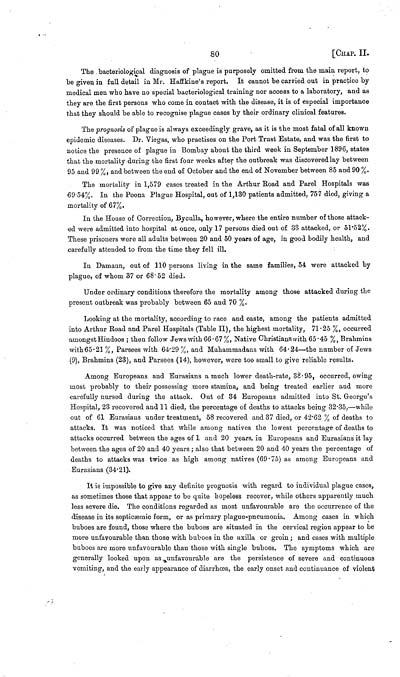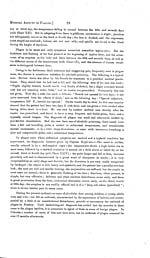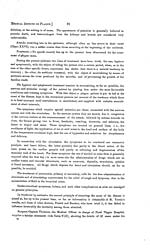Medicine - Disease > Bombay plague: being a history of the progress of plague in the Bombay presidency from September 1896 to June 1899
(110) Page 80
Download files
Individual page:
Thumbnail gallery: Grid view | List view

80 [CHAP. II.
The bacteriological diagnosis of plague is purposely omitted from the main report, to
be given in full detail in Mr. Haffkine's report. It cannot be carried out in practice by
medical men who have no special bacteriological training nor access to a laboratory, and as
they are the first persons who come in contact with the disease, it is of especial importance
that they should be able to recognise plague cases by their ordinary clinical features.
The prognosis of plague is always exceedingly grave, as it is the most fatal of all known
epidemic diseases. Dr. Viegas, who practises on the Port Trust Estate, and was the first to
notice the presence of plague in Bombay about the third week in September 1896, states
that the mortality during the first four weeks after the outbreak was discovered lay between
95 and 99%, and between the end of October and the end of November between 85 and 90%.
The mortality in 1,579 cases treated in the Arthur Road and Parel Hospitals was
6954%. In the Poona Plague Hospital, out of 1,130 patients admitted, 757 died, giving a
mortality of 67%.
In the House of Correction, Byculla, however, where the entire number of those attack-
ed were admitted into hospital at once, only 17 persons died out of 33 attacked, or 5152%.
These prisoners were all adults between 20 and 50 years of age, in good bodily health, and
carefully attended to from the time they fell ill.
In Damaun, out of 110 persons living in the same families, 54 were attacked by
plague, of whom 37 or 6852 died.
Under ordinary conditions therefore the mortality among those attacked during the
present outbreak was probably between 65 and 70%.
Looking at the mortality, according to race and caste, among the patients admitted
into Arthur Road and Parel Hospitals (Table II), the highest mortality, 7125 %, occurred
amongst Hindoos; then follow Jews with 6667%, Native Christians with 6545 %, Brahmins
with 6521%, Parsees with 6429%, and Muhammadans with 6424-the number of Jews
(9), Brahmins (23), and Parsees (14), however, were too small to give reliable results.
Among Europeans and Eurasians a much lower death-rate, 3895, occurred, owing
most probably to their possessing more stamina, and being treated earlier and more
carefully nursed during the attack. Out of 34 Europeans admitted into St. George's
Hospital, 23 recovered and 11 died, the percentage of deaths to attacks being 3235,-while
out of 61 Eurasians under treatment, 58 recovered and 37 died, or 4262% of deaths to
attacks. It was noticed that while among natives the lowest percentage of deaths to
attacks occurred between the ages of 1 and 20 years, in Europeans and Eurasians it lay
between the ages of 20 and 40 years; also that between 20 and 40 years the percentage of
deaths to attacks was twice as high among natives (6975) as among Europeans and
Eurasians (3421).
It is impossible to give any definite prognosis with regard to individual plague cases,
as sometimes those that appear to be quite hopeless recover, while others apparently much
less severe die. The conditions regarded as most unfavourable are the occurrence of the
disease in its septicmic form, or as primary plague-pneumonia. Among cases in which
buboes are found, those where the buboes are situated in the cervical region appear to be
more unfavourable than those with buboes in the axilla or groin; and cases with multiple
buboes are more unfavourable than those with single buboes. The symptoms which are
generally looked upon as unfavourable are the persistence of severe and continuous
vomiting, and the early appearance of diarrha, the early onset and continuance of violent
The bacteriological diagnosis of plague is purposely omitted from the main report, to
be given in full detail in Mr. Haffkine's report. It cannot be carried out in practice by
medical men who have no special bacteriological training nor access to a laboratory, and as
they are the first persons who come in contact with the disease, it is of especial importance
that they should be able to recognise plague cases by their ordinary clinical features.
The prognosis of plague is always exceedingly grave, as it is the most fatal of all known
epidemic diseases. Dr. Viegas, who practises on the Port Trust Estate, and was the first to
notice the presence of plague in Bombay about the third week in September 1896, states
that the mortality during the first four weeks after the outbreak was discovered lay between
95 and 99%, and between the end of October and the end of November between 85 and 90%.
The mortality in 1,579 cases treated in the Arthur Road and Parel Hospitals was
6954%. In the Poona Plague Hospital, out of 1,130 patients admitted, 757 died, giving a
mortality of 67%.
In the House of Correction, Byculla, however, where the entire number of those attack-
ed were admitted into hospital at once, only 17 persons died out of 33 attacked, or 5152%.
These prisoners were all adults between 20 and 50 years of age, in good bodily health, and
carefully attended to from the time they fell ill.
In Damaun, out of 110 persons living in the same families, 54 were attacked by
plague, of whom 37 or 6852 died.
Under ordinary conditions therefore the mortality among those attacked during the
present outbreak was probably between 65 and 70%.
Looking at the mortality, according to race and caste, among the patients admitted
into Arthur Road and Parel Hospitals (Table II), the highest mortality, 7125 %, occurred
amongst Hindoos; then follow Jews with 6667%, Native Christians with 6545 %, Brahmins
with 6521%, Parsees with 6429%, and Muhammadans with 6424-the number of Jews
(9), Brahmins (23), and Parsees (14), however, were too small to give reliable results.
Among Europeans and Eurasians a much lower death-rate, 3895, occurred, owing
most probably to their possessing more stamina, and being treated earlier and more
carefully nursed during the attack. Out of 34 Europeans admitted into St. George's
Hospital, 23 recovered and 11 died, the percentage of deaths to attacks being 3235,-while
out of 61 Eurasians under treatment, 58 recovered and 37 died, or 4262% of deaths to
attacks. It was noticed that while among natives the lowest percentage of deaths to
attacks occurred between the ages of 1 and 20 years, in Europeans and Eurasians it lay
between the ages of 20 and 40 years; also that between 20 and 40 years the percentage of
deaths to attacks was twice as high among natives (6975) as among Europeans and
Eurasians (3421).
It is impossible to give any definite prognosis with regard to individual plague cases,
as sometimes those that appear to be quite hopeless recover, while others apparently much
less severe die. The conditions regarded as most unfavourable are the occurrence of the
disease in its septicmic form, or as primary plague-pneumonia. Among cases in which
buboes are found, those where the buboes are situated in the cervical region appear to be
more unfavourable than those with buboes in the axilla or groin; and cases with multiple
buboes are more unfavourable than those with single buboes. The symptoms which are
generally looked upon as unfavourable are the persistence of severe and continuous
vomiting, and the early appearance of diarrha, the early onset and continuance of violent
Set display mode to: Large image | Zoom image | Transcription
Images and transcriptions on this page, including medium image downloads, may be used under the Creative Commons Attribution 4.0 International Licence unless otherwise stated. ![]()
| India Papers > Medicine - Disease > Bombay plague: being a history of the progress of plague in the Bombay presidency from September 1896 to June 1899 > (110) Page 80 |
|---|
| Permanent URL | https://digital.nls.uk/74586188 |
|---|




